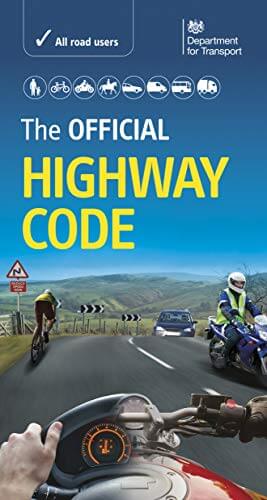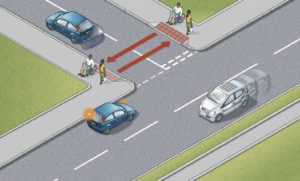The Highway Code has been updated for 2022. We discuss how big the changes are and how you should adapt to them.
The update to the rules of the road has raised some questions and concerns. At First Drive we have our say on the changes from an advanced driver and instructor point of view. Are there any changes to your driving style that need to be made?
Overview.
There are 8 updates or changes to the Highway Code 2022 and the first thing to do is look at the changes in more detail. Follow the link to read in depth the changes that have been made and how they might differ from things you may already do as a driver, rider or pedestrian.
https://www.gov.uk/government/news/the-highway-code-8-changes-you-need-to-know-from-29-january-2022
There are three main categories that have been changed:
- H1 – All road users and pedestrians
H1 relates to the hierarchy on the road, the bigger the vehicle the greater the responsibility you should take to care for others around you.
- H2 – Cars, motorbikes, cyclists and horses
H2 relates to protecting pedestrians crossing at junctions.
- H3 – Cars and motorcyclists
H3 relates to the safety of cyclists, the space you should give them and advice to keep themselves safer.
Reading between the lines.
The coverage of the changes across all media platforms has again highlighted the Highway Code to members of the public and society. This is only ever going to be a good thing. It is the base level for safe, considered and economical driving.
One thing raised from the consultation in 2021 about to proposed changes is it may be all well and good making the changes to improve our roads, but if they are not well documented or published then how are you supposed to implement them? The upshot has of course led to some declaring the changes dangerous and ridiculous.
There appears to be two areas of contention that are talked about a lot, H2 and H3.
H2 changes.
Possibly the most contentious rule change refers to giving way at junctions to pedestrians that are approaching, waiting or in the action of crossing. Many opinions have shared that the rule change makes it dangerous for cars and will increase crashes. This is categorically incorrect for these reasons:
- Junctions are dangerous in the first instance, are you applying enough caution with speed and observation?
- When approaching to turn left, you may need to stop anyway. You may not be able to see into the junction. Stop within the distance you can see to be clear.
- Approach the junction with a speed that is predictable, that communicates well with other road users.
- Plan to stop
After turning into or out of a junction without a problem for X number of years, have your senses to danger reduced? A collision is only a momentary lapse of concentration away. If you could say anything about these changes then it would be it increases the need for the driver to reduce speed and reduce risk.
If we apply some common sense to the rule we can see there is no ‘must’ in place. Use your own discretion and plan any stop in advance. Avoid sudden reactions. The main aim of the rule change is for drivers to increase awareness and consideration for others while driving.
Changes related to the use of a zebra crossing has cleared up what has always been a really grey area. Previously, cars would not need to give way to a user of the crossing until they’d stepped onto it. Therefore technically you could stand at the side of the road for an eternity. Normal habits however meant that a large number of road users would actually stop for a pedestrian if they appeared to want to use the crossing. Clarification now means what was once normal habit but incorrect has become normal advice from the Highway Code.
Rule 195.
Zebra and parallel crossings. As you approach a zebra crossing
- look out for pedestrians waiting to cross and be ready to slow down or stop to let them cross
- you should give way to pedestrians waiting to cross
- you MUST give way when a pedestrian has moved onto a crossing
- allow more time for stopping on wet or icy roads
- do not wave, flash your lights or use your horn to invite pedestrians across; this could be dangerous if another vehicle is approaching
- be patient, do not sound your horn or rev your engine as this can be intimidating
- be aware of pedestrians approaching from the side of the crossing.
A zebra crossing with a central island is two separate crossings.
The advice however comes accompanied by the word ‘should’ rather than ‘must’ but is still good to have clarified. Is a change of driving style required? Not if you already drive with consideration at the forefront.
H3.
Cyclists often cause areas of contention and friction when on the road. It is the same as with car users that the minority of cyclists let the majority down.
Car drivers often complain that cyclists:
- Go through red lights
- Use the pavement to avoid stopping
- Ride in the middle of the road
- Ride in large groups making it difficult to overtake
When training a new driver around cyclists and for that matter any other slower moving vehicle, it is important to reiterate that a delay is measured in a matter of seconds or at most a couple of minutes. In the grand scheme, this is not very long.
- Be patient and wait for the right opportunity to overtake, not just the first
- Give space when passing
The changes to the Highway Code only serve to reinforce good practice from both car drivers and riders.
The reporting of cyclists now being advised to cycle in the middle of the lane has had important details missed. The additional information is that this should happen when approaching junctions to the left, quieter roads and in traffic.
At a junction, if you are waiting to emerge, being able to see the cyclist earlier will make it safer for all. It would also discourage overtaking near junctions.
Cyclist responsibility.
Encouraging cyclists to ride two abreast is also an advantage for car drivers. It paints a picture in your mind that is a similar shape to a small car. This decreases the chances of drivers squeezing through gaps that do no exist. Overtaking is generally an under trained skill. When learning to drive it is not possible to engineer perfect scenarios to practice overtaking.
It is important also when cycling in groups to remember to ride in such a way that allows cars to pass safely, and you have a responsibility to do this. Groups of four, two abreast is a really practical way of dealing with this problem. The less time a driver spends on the wrong side of the road, the less time a driver is exposed to higher degrees of danger.
Conclusion.
Evolution is definitely the conclusion to the posed question. Many of the changes simply reinforce practices that would have been taught in the training stage but gradually forgotten over time. Avoiding the requirement to force everyone to retrain, amending the Highway Code to keep up with changes is a fair compromise.
Everyone has the responsibility for each other, plan ahead, take your time. The road network is only getting busier. Leave more time for your journey and positively think about what actions you are taking as a road user.
For further training see our advanced driving course or if you feel you would like to teach others how to drive then see our instructor training page.

